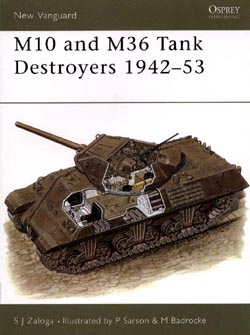 M10 and M36 Tank Destroyers 1942-53 M10 and M36 Tank Destroyers 1942-53
New Vanguard 57
By Steven J Zaloga
Colour Plates by Peter Sarson & Michael Badrocke
Osprey Publishing Ltd, 2002
ISBN 1-84176-469-8
48 pages Steve Zaloga’s latest for Osprey is a comprehensive account of the development and use of these two Sherman-based tank destroyers. The book begins with a look at the origins of the basic design, including the asinine doctrines adopted by the US Army under the aegis of General McNair, with various expedient types being tested and either dropped or put into limited service before it was realised that a fully-tracked vehicle based on the Sherman chassis was a better solution. The initial production M10 carried a 3-inch gun, but was designed to allow heavier weapons to be fitted in the same trunnions – a good decision as without it the British would not have been able easily to fit the 17 pounder gun into the turret and produce the Western Allies’ best anti-tank SP of World War 2. The next section is titled Initial Production, perhaps misleading since it covers all the changes made to the M10 during its production. These include, of course, the various turret counterweight designs, that had been found essential to allow the turret to traverse properly with its out-of-balance gun. Also covered are the bosses on the hull and turret, intended to allow up-armour kits to be fitted but eventually dropped from the production line since the up-armour kits themselves were never produced. Then comes the M10’s combat debut in Tunisia and Italy, with the lessons of combat being misread by the Tank Destroyer Command which dropped M!0 production in favour of towed guns – just another of many mistakes. The section headed Production Changes deals with experiments to add a machine gun pulpit to the turret, but has more to do with the conversion of surplus M10A1s into M35 gun tractors and the development of the M36. The M36 was an improved M10, with the more potent 90mm gun in a new turret mounted on the M10A1 chassis. .Its development is covered here, including the telling comment that the Tank Destroyer Command was marginalised due to its poor judgement in the past. Combat from Normandy to Germany comes next, with some interesting user comments as well as information about the unit-built turret roof designs. The users wanted head cover, though the Tank Destroyer Command had not thought it necessary. Pacific use, very limited, is dealt with in a very short section before attention turns to British service and the 17-pounder variant. After this comes French and Soviet Lend-Lease use, and finally post-War distribution of M10s and M36 to various armies. There’s a good selection of wartime photographs in this book, and though quite a few will be familiar they are all together here instead of being scattered through several books. As Steve Zaloga notes, there is no other single book on the M10 and M36! The colour plates are perhaps a little disappointing at first glance, with only a few showing the front and rear markings. A second look shows that several are based on single side-view photographs, reproduced in the book – so it’s not surprising that those markings aren’t shown since no-one knows what they were. With the current crop of M10 kits, and at least one M36 expected, this is a great reference for modellers. Highly recommended. | 







|
 M10 and M36 Tank Destroyers 1942-53
M10 and M36 Tank Destroyers 1942-53






